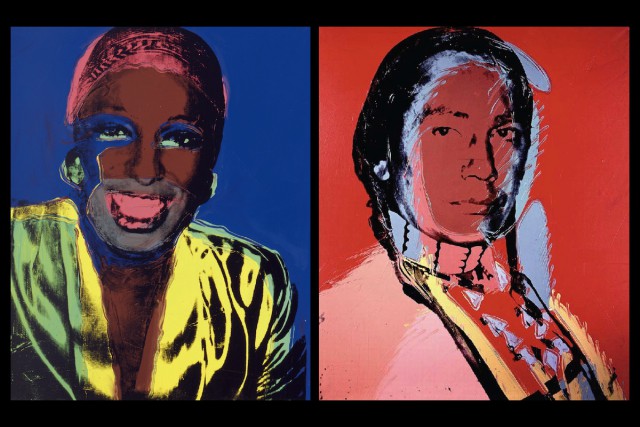Art World
Andy Warhol’s Brand-New Work
THE DAILY PIC: Volume four of Andy's collected works could be his latest piece.

THE DAILY PIC: Volume four of Andy's collected works could be his latest piece.

Blake Gopnik


It has been 27 years since Andy Warhol’s death, and he just produced a phenomenal new piece. It’s called The Andy Warhol Catalogue Raisonné: Volume 4, Paintings and Sculpture late 1974–1976. It’s a vast, blocky thing that weighs almost 10 pounds, so I’m not sure if it’s a sculpture, Andy’s latest venture in publishing—it has more than 600 pages and hundreds of photos—or even a kind of meta-view of his practice as a meta-painter. (Today’s Daily Pic shows catalogue numbers 2861 and 3416, out of the 608 items listed in the book.) Whatever its proper art-historical category, the volume fits perfectly into Warhol’s lifelong practice of blurring every boundary between his art, his life, and his business. Taking in this beast of a book, it feels as though the catalogue raisonné, rather than any individual work he turned out, had always been the end-goal of his art production, especially in the ’70s. The book seems less like a compendium of unique pieces intended for separate contemplation as like a record of a life lived as an artist, with the art objects in it as nothing more than documentation of that live “performance.”
In just the way that Warhol swept the daily contents of his desk into the cardboard boxes that became the artwork known as the Time Capsules (Warhol begins to gather them at just the moment where this book takes off), so here a few years of his practice as an artist gets swept into a single volume, where we can contemplate it as the all-in-one work I think it really was. And as usual with Warhol, he relies on others to do much of his grunt-work: in the case of this book, the Warholian “assistants” are the editor Neil Printz and the team working with him at the Andy Warhol Foundation for the Visual Arts, not to mention the people at its publishers, Phaidon.
A few principal “art supplies” go into the two-year artwork represented by this book: 268 canvases portraying transvestites, known as the Ladies and Gentlemen series; 224 portraits of identified sitters, both famous (Mick Jagger, Jimmy Carter) and little-known but well-heeled; and a few more varied projects, such as pictures of pets (both stuffed and live), of random still-life subjects and of a “representative” American Indian. As per the volume’s title, there’s also one work of (almost) sculpture: a now-lost installation of burglar alarms that Warhol set to go off, as a piece of sound art, whenever anyone stepped into a particular spot in his third Factory.
That unknown, long vanished Invisible Sculpture, as Warhol called it, is the key to everything else that’s going on here: It shows Warhol to be a dedicated, aggressive avant-gardist–the same one that lurks behind everything else he did, no matter how commercial the project.
The Ladies and Gentlemen were made for an Italian dealer, but the catalogue raisonné shows how Warhol made many, many more canvases than that commission required, and kept many of them with him until his death. In his fascination with the subject, he also shot hundreds more Polaroids than he could ever have needed, of more models than he portrayed in the silkscreens. The models that did get onto canvas are portrayed in a new technique that lets Warhol blur their features under messy paint and complex overlays of color. The technique works as an excellent metaphor for the ill-defined status of drag queens in our culture, and our inability to see clearly who and what they are. These models, and their renderings by Warhol, are messiness incarnate. The public canvases of the Ladies and Gentlemen series are almost as much about illegibility and cancelling out as they are about bringing into view. Lined up across page after page in the book, they start to feel like the stuttering, half-melted frames of a film that has got caught in a projector’s broken gate. Whereas the private Polaroids that record Warhol’s actual interactions with the trannies—amazingly, all 503 are reproduced in the book—reveal a much more direct, untroubled vision.
Warhol’s celebrity portraits, in contrast, mostly achieve a washed out legibility that makes their sitters almost interchangeable–tokens of the way fancy people are supposed to look, rather than true explorations of their characters or personas. They are much closer to Warhol’s barely varied images of Campbell’s soup flavors than they are like the deep gaze of his Screen Tests of friends and acolytes. Spread out across the catalogue raisonné, these paying sitters become the commodities they really were for Warhol, in the project that brought his studio closest to achieving true factory-style production.
The book provides a decent model, I think, for the varied contents of Warhol’s brain as an artist: He lived with, and worked inside, the overview of his art than the rest of us are only getting now, thanks to Printz and his team. (Images © 2014 The Andy Warhol Foundation for the Visual Arts, Inc. / Artists Rights Society (ARS), New York)
For a full survey of past Daily Pics visit blakegopnik.com/archive.